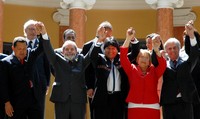In the 21st century so far, regional integration has been one of the most notable elements of South American foreign relations. Picking up speed in recent years, the continent's heads of state have enthusiastically met in numerous summits, promising increased political, economic, social, and development cooperation. Across the spectrum, governments are expanding current integration frameworks and entering into new agreements. Expectations are no less grand. As Brazil's President Luis Inacio "Lula" da Silva recently stated, "South America, united, will move the board game of power in the world, not for its own benefit, but for everyone's." Economic integration is a starting point for this bold agenda. South American nations are pushing to deepen already existing sub-regional trade organizations, in particular the Southern Common Market (Mercosur) and the Andean Community (CAN). These two groups are also negotiating with each other, with the goal of creating a South America Free Trade Area (SAFTA). In addition to trade-based integration agreements, South American countries recently formed a new regional financing vehicle, the Bank of the South. Spearheaded by Venezuelan President Hugo The economic efforts extend to basic infrastructure development as well. Grand announcements include a "gasoducto del sur" that would connect Venezuela, Brazil, and Argentina with over 5,000 miles of pipeline, and an "energy ring" linking Peru, Chile, Argentina, Brazil and Uruguay also by gas pipeline. While these ambitious projects remain on the drawing board, others move forward. In 2000, the region's presidents launched a South American Regional Infrastructure Integration Initiative (IIRSA) to strengthen transportation, energy and communications matrices. Since then, nearly $70 billion has been invested in projects that include the modernization of Chilean ports, the development of inner-city bus systems in Colombia and Venezuela, and the construction of the Inter-Oceanic Road Corridor between Brazil and Peru.
The Promise and Perils of South American Integration

